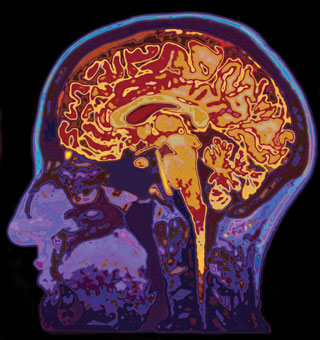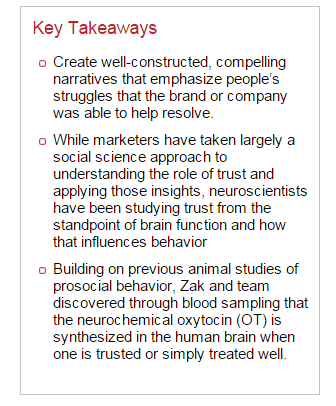 The important role of trust in building strong customer relationships has been widely discussed in marketing since the early 1990s. There are many working definitions of trust, but most revolve around the confident expectation of honest dealings, reliability, promise keeping and not being taken advantage of when vulnerable. Paper-and-pencil measures of trust indicate an emotional connection to the other party, but trust also can have a rational component.
The important role of trust in building strong customer relationships has been widely discussed in marketing since the early 1990s. There are many working definitions of trust, but most revolve around the confident expectation of honest dealings, reliability, promise keeping and not being taken advantage of when vulnerable. Paper-and-pencil measures of trust indicate an emotional connection to the other party, but trust also can have a rational component.
Various models have been proposed and tested over the years (including one by my co-author of this column), which demonstrate a link between trust and customer loyalty and commitment, leading to higher levels of repurchase, share of wallet, cross-selling, referrals, general buyer-seller cooperation, etc. Various drivers of trust also have been identified, including (but not limited to) the frequency and quality of communication, source credibility and expertise, having similar characteristics and shared values, the absence of opportunistic behavior, mutual disclosure, the build-up of a consistent history of positive interactions, etc. These (presumably) causal linkages appear robust across many different B-to-C and B-to-B contexts, and seem to apply whether the objects of trust are people, firms or brands.
While marketers have taken largely a social science approach to understanding the role of trust and applying those insights, neuroscientists have been studying trust from the standpoint of brain function and how that influences behavior. Their findings are mostly in line with what marketers believe to be true about trust, but they offer a deeper level of explanation and validation. Moreover, they point to additional levers that marketers can use to build brand trust and engagement.
Laboratory work by my co-author, Paul Zak, and his colleagues at Claremont Graduate University has uncovered an apparent “switch” in the brain that can “turn on” trust. Building on previous animal studies of prosocial behavior, Zak and team discovered through blood sampling that the neurochemical oxytocin (OT) is synthesized in the human brain when one is trusted or simply treated well. The OT molecule, in turn, motivates reciprocation. The release of OT signals that the other party is “safe” to be around and that cooperative behavior will not be exploited. Similar to lab rodents, the synthesis of OT motivates people to treat the other party “like family.” Functional MRI has shown that infusing people with OT reduces fear-associated brain activity. A link to social science research is a positive correlation between the amount of OT released and expressed feelings of empathy toward the other party and “wanting to help.” OT appears to be the neurochemical that emotionally connects us to others by enhancing empathy, which is why it is sometimes called the “love hormone” (think brand love).

Imagine how this process might work in a sales situation. You are meeting for the first time with a new insurance agent, and the agent voluntarily discloses to you how he failed to make a prudent financial decision in the past, for all of the wrong reasons, and suffered a loss. The agent then expresses his fervent desire that you not make the same mistake. Awash in OT for having been made privy to this personal and somewhat revealing information, your trust in the agent and company increases and you reciprocate by buying a $100,000 policy. This illustration is not a far leap from the person-to-person research conducted in Zak’s lab over the past decade. For example, these experiments showed how human subjects would return money to a trusting investor, and that the amount of money returned correlated positively with the amount of OT synthesized in the brain.
Perhaps more exciting for marketing are recent improvements in the measurement of OT release and new observations about its triggers. Taking a blood sample to measure OT is highly invasive and it is also a point-in-time measurement. Consequently, it’s difficult to observe the ebb and flow of brain function over time in response to external stimuli. Fortunately, Zak and his team have discovered a less invasive means of measuring OT via the electrocardiogram (ECG), which can track the activity of the vagus nerve, and it turns out that the vagus nerve is chock full of OT receptors. Unlike blood sampling, the ECG provides continuous measurement of up to one thousand times per second. To complement the ECG, the researchers also are measuring the fast-acting arousal hormone ACTH, which is correlated with stimulus attention, and is indicated by a quickened heartbeat and sweat coming from the eccrine glands. Sweat can be continuously measured via an electrodermal sensor on the fingers.
Armed with these improved tools for measuring OT and ACTH, coupled with terabytes of peripheral neurological data for control purposes (talk about “Big Data”!), the researchers have been examining brain function in response to character-driven stories, the empathy that is created and the behavior that results. The studies involve exposing human subjects to public service announcements and, more recently, commercials, monitoring brain response down to the millisecond and correlating that with the behavior that ensues, such as making a donation to the cause depicted in the PSA. These investigations are particularly relevant to building brand trust, which often necessitates a more media-laden approach (both traditional and social) in lieu of direct personal contact. The findings point to the importance of narrative structure and suggest that the verbal expression of liking may be an unreliable indicator of what is really going on in the brain.
High-impact narratives cause people to first pay attention and then to get involved emotionally with the characters. Both are required to move people to action. Attention-getting stories tend to follow a dramatic arc of suspense, a climax and tension release. It appears that the brain waxes and wanes across the narrative arc as the characters are developed, with the peak attentional response occurring in the climax (increased heartbeat and sweat indicating ACTH). Attention provides the vehicle for narrative immersion, pulling the person into the story’s world and allowing her to relate to the story’s characters. The OT response lags the attentional response, as empathy and concern with the characters grows along with the desire for wanting to help.
The key takeaway for marketers is to create well-constructed, compelling narratives that emphasize people’s struggles that the brand or company was able to help resolve. Out of that empathetic response emerges trust, with OT being the elixir, and with trust comes the willingness to further engage with the brand.
Written by By: Lawrence A. Crosby & Paul J. Zak
Author Bio:Lawrence A. Crosby is dean of the Peter F. Drucker-Masatoshi Ito Graduate School of Management at the Claremont Graduate University, and PAUL J. ZAK is the founding director of the university’s Center for Neuroeconomics and a professor of behavioral economics
Source:ama.org


